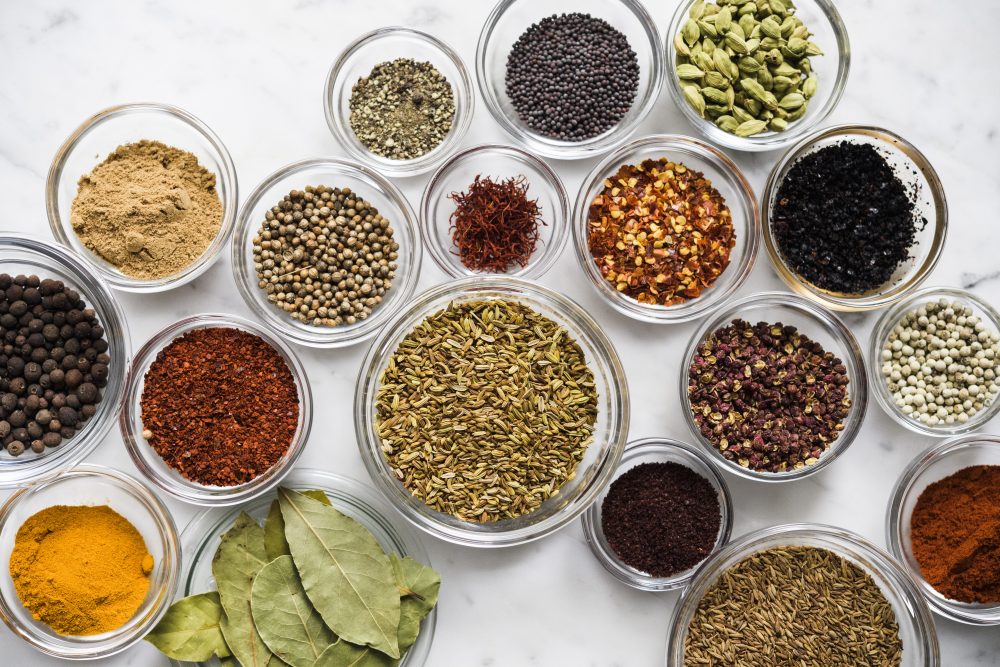If there’s anyone you should listen to on the subject of spices, it’s Lior Lev Sercarz. The Israel-born chef is known to many as the “spice therapist” and owns New York City’s La Boite, which sells over 50 custom spice blends, hosts classes and collaborates with chefs, bartenders and restaurants. Speaking with Christopher Kimball on Milk Street Radio recently, Sercarz shared a handful of useful tips for buying, storing and using spices—simple steps that will change the way you cook.
Most importantly, however, is how inclusive he is: “Anything in a dry format that I can use to season my food is a spice to me,” he says. That means dried herbs and barks, but also dried fruits and vegetables and even dried cheese, seaweed and seafood. When practically anything can become a spice, a world of possibilities opens up, and that is the genius behind Sercarz’s approach.
He doesn’t just use spices to season, either. Some can actually play mind games. Take pimenton, Spain’s smoked paprika, smoked chipotles or even smoked salt. “They trick your brain in a very positive way to think about an item that was grilled or cooked over fire, and that really sets a tone,” Sercarz says. Combining certain spices and foods can have a similarly deceptive effect. Once, after tasting peppercorns, a sip of coffee tasted surprisingly sweet, so now he adds spices to his morning cup.
Watch: "A Simple Way to Spice Up Coffee"
“The challenge for many years was that if you used spices, you had to cook ‘exotic’ or ‘foreign’ dishes. But now, we are finally at the point—or getting there—when you can make a traditional clam chowder and give it a spin with spices from elsewhere,” he says. “I think the idea of mastering your cuisine and becoming comfortable in it is the most important thing, and then you can start accessorizing with those spices that take a dish from just okay to unbelievably delicious and exciting.”
How Long Should You Keep Your spices?
“If you’re asking that question, they should probably not be in your kitchen anymore,” Sercarz says. “If you look at them and you don’t remember how long you had them, then that’s already a bad sign.” Buy in small quantities, buy whole when possible and follow the spice therapist’s advice: When you buy a jar, before putting it away in your kitchen, label it a year from the date of purchase. Then you’ll have a visible reminder to toss and buy new before the year is out.
What to Look for When Buying Spices
Evaluate their shape and color: They should be solid and vibrant. For example, “if you’re purchasing whole black peppercorn and they’re not really black, that could be a sign that they’re not fully ripened or fully dried,” Sercarz explains. “If they’re half whole and half powder, they might be really old and falling to dust.”
How to Make Your Own Spices
When your herbs start to turn or if you have a large batch and don’t know if you’ll use them all, turn them into spices, Sercarz suggests. Lay them out on a parchment paper-lined cookie rack with a tray underneath, and within a few days, the herbs will dry up and be ready to use. This works particularly well with mint, basil, tarragon and parsley, but you can use the same method to dry out citrus peels. Use in tea, for roasting or for cooking meats.
6 Spices Every Cook Should Keep In the Pantry
Cumin Seeds
Let us count the ways… After pepper, it’s our most frequently used spice.
Coriander
Citrusy and floral, it’s something Sercarz always keeps on hand.
Fennel Seeds
Polarizing because of their licorice-like flavor, but worth stepping out of your comfort zone for.
A Chili Flake
Sercarz likes Urfa or Aleppo chili. If you’re unfamiliar with Urfa pepper, it’s a poblana-shaped pepper that grows in the south of Turkey and as Sercarz describes, “for some beautiful, mysterious way, it has a nose as if you just smelled a jar of chocolate.” He loves it so much that he often has to hide his jar, lest it end up in everything he’s cooking. Ginger: Versatile and powerful thanks to its citrus notes and subtle heat.
Cinnamon
Don’t overlook cinnamon as a seasoning for savory dishes. Sercarz loves it for roasting vegetables, flavoring poultry and even in tomato sauce.
A Surprising Way to Harness Flavor
Some chilis are undoubtedly too hot for everyone’s palate, but that doesn’t have to mean missing out. On a recent trip to India, Sercarz was intrigued to find a chef who took hot dried chilies and blanched them to soften the heat, showing that these spicy varieties had fantastic flavor underneath.



